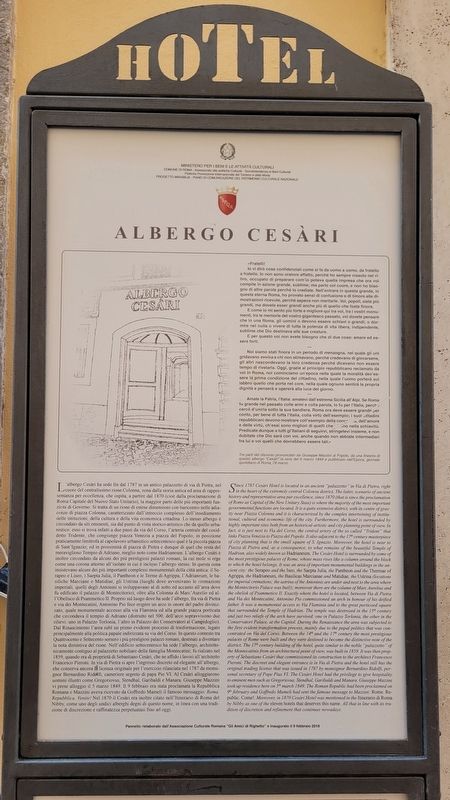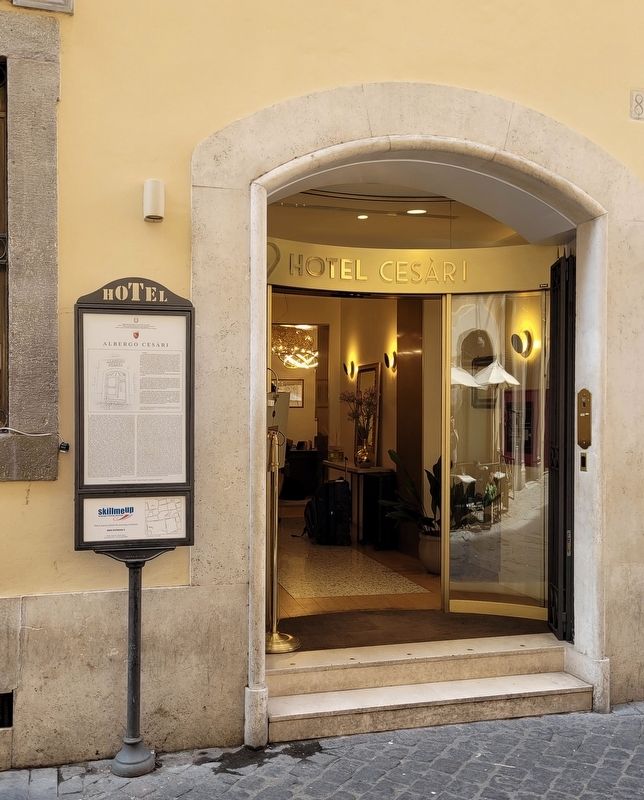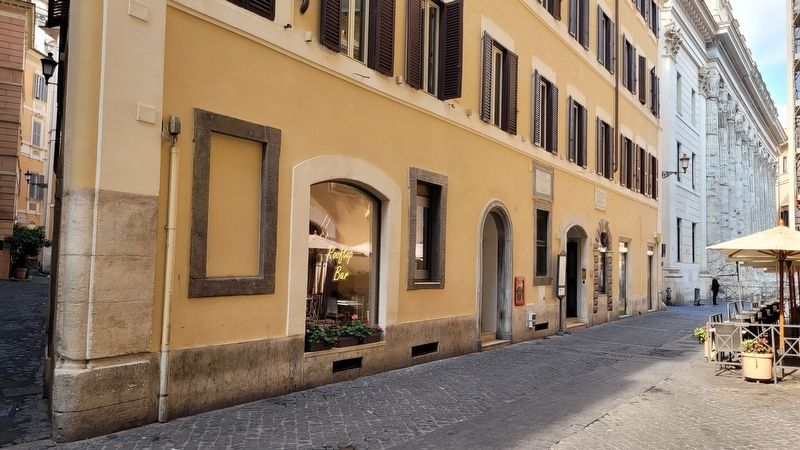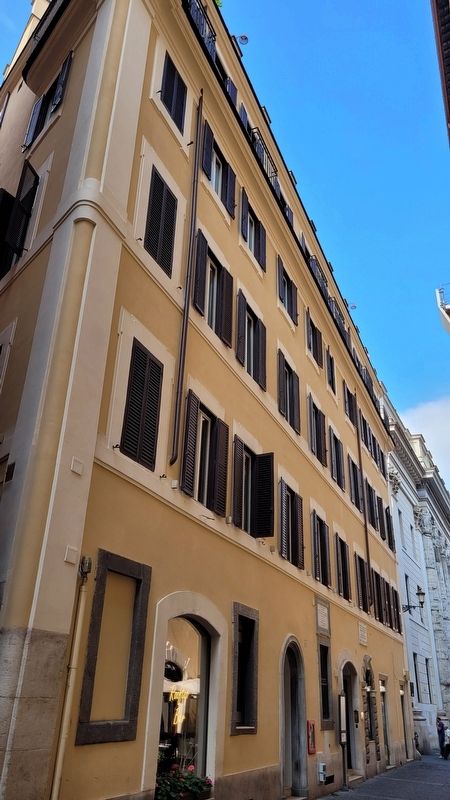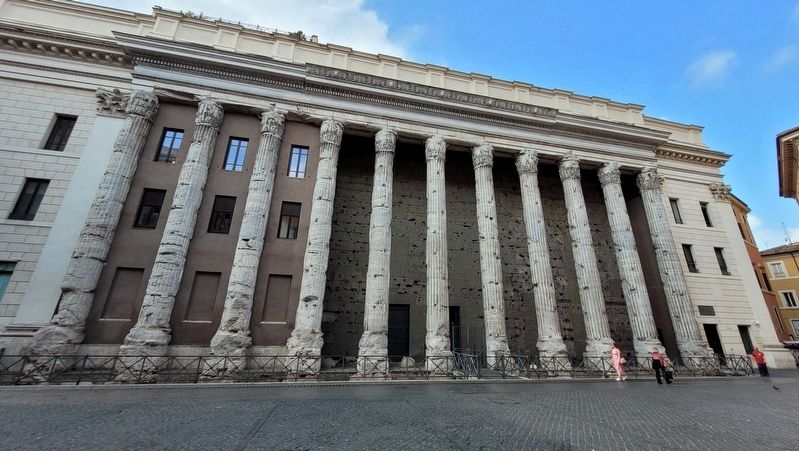Colonna in Roma in Città metropolitana di Roma Capitale, Latium, Rome, Italy — Central Italy (Tyrrhenian Coast)
Albergo Cesari
— Hotel —
"Fratelli!
Io vi dirò cose confidenziali come si fa da uomo a uomo, da fratello a fratello. Io non sono oratore affatto, perché ho sempre vissuto nel ritiro, occupato di preparare com'io poteva quella impresa che ora voi compite in azione grande, sublime; ma parlo col cuore, e non ho bisogno di altre parole perché lo crediate. Nell'entrare in questa grande, in questa eterna Roma, ho provato sensi di confusione e di timore alle dimostrazioni ricevute, perché sapeva non meritarle. Voi, popoli, siete più grandi, ma dovete esser grandi anche più di quello che foste finora.
E
come io mi sento più forte e migliore qui tra voi, tra i vostri monumenti, tra le memorie del vostro gigantesco passato, voi dovete pensare che in una Roma, gli uomini o devono essere schiavi o grandi; o dormire nel nulla o vivere di tutta la potenza di vita libera, indipendente, sublime che Dio destinava alle sue creature.
E per questo voi non avete bisogno che di due cose: amare ed essere forti.
Noi siamo stati finora in un periodo di menzogna, nel quale gli uni gridavano evviva a chi non stimavano, perché credevano di giovarsene, gli altri nascondevano la loro credenza perché dicevano non essere tempo di rivelarla. Oggi, grazie al principio repubblicano reclamato da voi in Roma, noi cominciamo un'epoca nella quale la moralità dev'essere la prima condizione del cittadino, nella quale l'uomo porterà sul labbro quello che porta nel core, nella quale ognuno sentirà la propria dignità e penserà e opererà alla luce del giorno.
Amate la Patria, l'Italia: amatevi dall'estrema Sicilia all'Alpi. Se Roma fu grande nel passato colle armi e colla parola, lo fu per l'Italia, perch cercò d'unirla sotto la sua bandiera. Roma ora deve essere grande per conto, per bene di tutta l'Italia, colla virtù dell'esempio; i suoi cittadini repubblicani devono mostrare coll'esempio della conc a, dell'amore e delle virtù, ch'essi sono migliori di quelli che no nella schiavitù. Predicate dunque a tutti gl'Italiani di seguirvi, stringetevi insieme, e non dubitate che Dio sarà con voi, anche quando non abbiate intermediari fra lui e voi quelli che dovrebbero essere tali."
Tre parti del discorso pronunciato da Giuseppe Mazzini al Popolo, da una finestra di questo albergo "Cesari" la sera del 6 marzo 1849 e pubblicato nell'Epoca, giornale quotidiano di Roma, l'8 marzo.
Since 1787 Cesari Hotel is located in an ancient "palazzetto" in Via di Pietra, right in the heart of the extremely central Coloma district. The latter, scenario of ancient history and representative area par excellence, since 1870 (that is since the proclamation of Rome as Capital of the New Unitary State) is where the majority of the most important governmental functions are located. It is a quite extensive district, with its centre of gravity near Piazza Colonna and it is characterized by the complex intertwining of institutional, cultural and economic life of the city. Furthermore, the hotel is surrounded by highly important sites both from an historical-artistic and city planning point of view. In fact, it is just next to Via del Corso, the central artery of the so called "Trident" that links Piazza Venezia to Piazza del Popolo. It also adjacent to the 17th century masterpiece of city planning that is the small square of S. Ignazio. Moreover, the hotel is near to Piazza di Pietra and, as a consequence, to what remains of the beautiful Temple of Hadrian, also widely known as Hadrianeum. The Cesari Hotel is surrounded by some of the most prestigious palaces of Rome, whose mass rises like a column around the block to which the hotel belongs. It was an area of important monumental buildings in the ancient city: the Serapeo and the Iseo, the Saepta Julia, the Pantheon and the Thermae of Agrippa, the Hadrianeum, the Basilicas Marcianae and Matidiae, the Ustrina (locations for imperial cremations; the ustrina of the Antoninis are under and next to the area where the Montecitorio Palace was built); moreover there are the column of Marc Aurelius and the obelisk of Psammetico II. Exactly where the hotel is located, between Via di Pietra and Via dei Montecatini, Antonino Pio commissioned an arch in honour of his deified father. It was a monumental access to Via Flaminia and to the great porticoed square that surrounded the Temple of Hadrian. The temple was destroyed in the 15th century and just two reliefs of the arch have survived: one in Palazzo Torlonia, the other in the Conservatori Palace, at the Capitol. During the Renaissance the area was subjected to the first evident transformation process, mainly due to the papal politics that was concentrated on Via del Corso. Between the 14th and the 17th century the most prestigious palaces of Rome were built and they were destined to become the distinctive note of the district. The 17th century building of the hotel, quite similar to the noble "palazzetto" of the Montecatinis from an architectural point of view, was built in 1859. It was then property of Sebastiano Cesari that commissioned its construction to the architect Francesco Pieroni. The discreet and elegant entrance is in Via di Pietra and the hotel still has the original trading license that was issued in 1787 by monsignor Bernardino Ridolfi, personal secretary of Pope Pius VI. The Cesari Hotel had the privilege to give hospitality to eminent men such as Gregoriovus, Stendhal, Garibaldi and Manara. Giuseppe Mazzini took up residence here on 5th march 1849. The Roman Republic had been proclaimed on 9th february and Goffredo Mameli had sent the famous message to Mazzini: Rome. Republic. Come!. Moreover, in 1870 Cesari Hotel was mentioned in the Itinerario di Roma by Nibby as one of the eleven hotels that deserves this name. All that in line with its tradition of discretion and refinement that continues nowadays.
Brothers!
I will tell you confidential things as one does from man to man, from brother to brother. I'm not an orator at all, because I've always lived in retreat, busy preparing as best I could that enterprise that you are now carrying out in great, sublime action; but I speak from the heart, and I need no other words for you to believe it. On entering this great, this eternal Rome, I felt a sense of confusion and fear at the demonstrations I received, because I knew I didn't deserve them. You peoples are bigger, but you must be even bigger than you were up to now.
And just as I feel stronger and better here among you, among your monuments, among the memories of your gigantic past, you must think that in a Rome, men must either be slaves or great; either sleep in nothingness or live on all the power of free, independent, sublime life that God destined for his creatures.
And for this you need only two things: to love and to be strong.
Up until now we have been in a period of lies, in which some shouted cheers to those they did not esteem, because they believed they would benefit from it, the others hid their belief because they said it was not time to reveal it. Today, thanks to the republican principle demanded by you in Rome, we are beginning an era in which morality must be the first condition of the citizen, in which man will carry on his lip what he carries in his heart, in which everyone will feel his own dignity and will think and work in the light of day.
Love your homeland, Italy: love each other from extreme Sicily to the Alps. If Rome was great in the past with weapons and with words, it was for Italy, because she tried to unite her under her banner. Rome must now be great on behalf, for the good of all Italy, with the virtue of example; its republican citizens must show by the example of the conch, of love, and of the virtues, that they are better than those who are not in slavery. Therefore preach to all Italians to follow you, stick together, and do not doubt that God will be with you, even when you do not have intermediaries between him and you who should be such."
Three parts of the speech delivered by Giuseppe Mazzini to the People, from a window of this "Cesari" hotel on the evening of March 6, 1849 and published in Epoca, the daily newspaper of Rome, on March 8.
Erected by Ministero per i Beni e le Attività Culturali, Comune di Roma, Assessorato alle Politiche Culturali, Sovraintendenza ai Beni Culturali, Politiche Promozione Internazionale del Turismo e della Moda, Progetto Mirabilia and Piano di Comunicazione del Patrimonio Culturale Nazionale.
Topics. This historical marker is listed in these topic lists: Architecture • Arts, Letters, Music • Industry & Commerce. A significant historical date for this entry is March 5, 1849.
Location. 41° 53.998′ N, 12° 28.798′ E. Marker is in Roma, Lazio (Latium, Rome), in Città metropolitana di Roma Capitale. It is in Colonna. Marker is at the intersection of Via di Pietra and Via de Burro, on the left when traveling west on Via di Pietra. The marker is located at the front entrance to the hotel. Touch for map. Marker is at or near this postal address: Via di Pietra 68, Roma, Lazio 00186, Italy. Touch for directions.
Other nearby markers. At least 8 other markers are within walking distance of this marker. Trevi-Pantheon Route (within shouting distance of this marker); a different marker also named Trevi-Pantheon Route (about 90 meters away, measured in a direct line); Palazzo Sciarra-Colonna / Sciarra-Colonna Palace (about 90 meters away); a different marker also named Trevi-Pantheon Route (about 150 meters away); L'eclisse / The Eclipse (about 180 meters away); Hotel Pantheon (about 210 meters away); a different marker also named The Trevi-Pantheon Route (about 240 meters away); Chiesa di Santa Rita delle Vergini / Church of Santa Rita of the Virgins (about 240 meters away). Touch for a list and map of all markers in Roma.
Also see . . .
1. Giuseppe Mazzini. Wikipedia
Giuseppe Mazzini ; 22 June 1805 – 10 March 1872) was an Italian politician, journalist, and activist for the unification of Italy (Risorgimento) and spearhead of the Italian revolutionary movement. His efforts helped bring about the independent and unified Italy in place of the several separate states, many dominated by foreign powers, that existed until the 19th century.[8] An Italian nationalist in the historical radical tradition and a proponent of a republicanism of social-democratic inspiration, Mazzini helped define the modern European movement for popular democracy in a republican state.(Submitted on July 24, 2023, by James Hulse of Medina, Texas.)
2. Temple of Hadrian. Wikipedia
The Temple of Hadrian (Templum Divus Hadrianus, also Hadrianeum) is an ancient Roman structure on the Campus Martius in Rome, Italy, dedicated to the deified emperor Hadrian by his adoptive son and successor Antoninus Pius in 145 CE.(Submitted on July 24, 2023, by James Hulse of Medina, Texas.)
Credits. This page was last revised on July 24, 2023. It was originally submitted on July 23, 2023, by James Hulse of Medina, Texas. This page has been viewed 224 times since then and 12 times this year. Photos: 1, 2, 3, 4, 5. submitted on July 24, 2023, by James Hulse of Medina, Texas.
